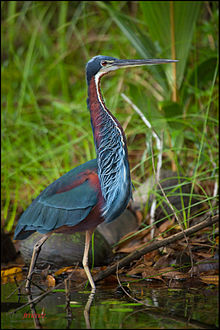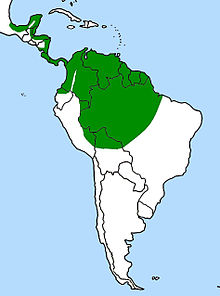Agami heron
| Agami heron | |
|---|---|

| |
| Adult in Costa Rica | |
| Scientific classification | |
| Domain: | Eukaryota |
| Kingdom: | Animalia |
| Phylum: | Chordata |
| Class: | Aves |
| Order: | Pelecaniformes |
| Family: | Ardeidae |
| Subfamily: | Ardeinae |
| Genus: | Agamia Reichenbach, 1853 |
| Species: | A. agami
|
| Binomial name | |
| Agamia agami (Gmelin, 1789)
| |

| |
| Global range | |
The agami heron (Agamia agami) is a medium-sized heron. It is a resident breeding bird from Central America south to Peru and Brazil. It is sometimes known as the chestnut-bellied heron, and is the only member of the genus Agamia. In Brazil it is sometimes called Soco beija-flor, meaning 'hummingbird heron', thanks to its unique coloration pattern.[2]
The agami heron is listed as vulnerable by the IUCN, due to predictions of future habitat destruction within its range.[1]
Taxonomy
[edit]The agami heron was formally described in 1789 by the German naturalist Johann Friedrich Gmelin in his revised and expanded edition of Carl Linnaeus's Systema Naturae. He placed it with the herons and cranes in the genus Ardea and coined the binomial name Ardea agami.[3] Gmelin based his description on the "Agami heron" from Cayenne that had been described in 1785 by the English ornithologist John Latham in his book A General Synopsis of Birds.[4] Latham had in turn based his description on a specimen owned by the army officer Thamas Davies and the description and illustration of "Le Héron Agami" by the French polymath Comte de Buffon in his Histoire Naturelle des Oiseaux.[5][6] The agami heron is now the only species placed in the genus Agamia that was introduced in 1853 by the German naturalist Ludwig Reichenbach.[7][8] The name agami is the word for Grey-winged trumpeter that's used by the indigenous people of French Guiana.[9] The species is monotypic: no subspecies are recognised.[8]
Description
[edit]
This uncommon species is 66–76 centimetres (26–30 inches) in length. It is short-legged for a heron, and has a thin bill which is considerably longer than the head. The neck and underparts are chestnut, with a white line down the centre of the foreneck, and the wings are shiny green. Wispy pale blue feathers decorate the crown, sides of the foreneck, and lower back. The legs, bill, and bare facial patch are dull yellow. During the breeding season the facial patch can change color to reddish. The sexes are similar, but juveniles are largely brown above with a white foreneck, and streaked brown-and-white underparts. The normal clutch size is two blue eggs.
Distribution and habitat
[edit]The agami heron is a Neotropical species occurring in Central and South America. The distribution area of the species extends from south-east Mexico through central and Caribbean Central America through the Amazon basin in South America, covering the following countries: Mexico, Guatemala, Belize, El Salvador, Honduras, Nicaragua, Costa Rica, Panama, Colombia, Ecuador, French Guiana, Suriname, Guyana, Venezuela, Peru, Bolivia and Brazil.
This species is rare in open areas. The agami heron's habitat encompasses swamp forests, mangroves, forest streams and freshwater wetlands. They mostly occur at elevations between sea level and 300 metres (1,000 feet), although records exist from as elevations as high as 2,600 metres (8,500 feet) in the Andes. They nest in both single species and mixed species colonies on platforms of sticks in bushes and trees over water. Very few colonies are known to date but some are quite large, up to hundreds or even over a thousand nests.[10] The following locations of colonies are known within the distribution area of the species:on a tiny island at the centre of a lagoon in the middle of the Pacuare Nature Reserve, Costa Rica, in the Tapiche Reserve, Peru, the Marais de Kaw-Roura National Reserve and Amazonian National Park, French Guiana, and other colonies outside of protected areas in Colombia, Mexico and Belize.[11]
Behavior
[edit]Despite its stunning plumage, this reclusive species' preference for shade and overhanging vegetation means that it is rarely seen. This is a quiet bird, but pairs and family groups may make various snoring or rattling sounds. Rattling sounds and slow walking away are a typical response to disturbance.[12]
Agami herons stalk their prey (fish, frogs, small reptiles, and snails) in shallow shaded water in forested areas. They often stand still on perches or directly in the water, or moving very slowly.[12] They rarely wade in open water. The majority of their prey consists of characins (Triportheus angulatus and Astyanax angulatus) which are surface-swimming fishes. Less commonly, they have also been known to consume cichlids (Aequidens).[13]
Several courtship behaviors have been described and are used by both sexes.[12] Lores can change color to an intense red, and both sexes show a short-lived silver crest.
Conservation
[edit]This species is very discreet and scientifically little known, which is a challenge for conservationists. Its remote habitat and secretive behavior may explain its apparent rarity. However, it is considered as Vulnerable by the IUCN Red List due to future habitat loss in the Amazon.[1] Conservation efforts should concentrate on protection of important colony sites, developing a better understanding of the range, habitat needs and biology of the species.[11]
References
[edit]- ^ a b c BirdLife International. (2023). "Agamia agami". IUCN Red List of Threatened Species. 2023: e.T22697200A171903244. doi:10.2305/IUCN.UK.2023-1.RLTS.T22697200A171903244.en.
- ^ "garça-da-mata (Agamia agami) | WikiAves - A Enciclopédia das Aves do Brasil". www.wikiaves.com.br. Retrieved 2017-01-17.
- ^ Gmelin, Johann Friedrich (1789). Systema naturae per regna tria naturae : secundum classes, ordines, genera, species, cum characteribus, differentiis, synonymis, locis (in Latin). Vol. 1, Part 2 (13th ed.). Lipsiae [Leipzig]: Georg. Emanuel. Beer. p. 629.
- ^ Latham, John (1785). A General Synopsis of Birds. Vol. 3, Part 1. London: Printed for Leigh and Sotheby. p. 97.
- ^ Buffon, Georges-Louis Leclerc de (1780). "Le Héron Agami". Histoire Naturelle des Oiseaux (in French). Vol. 7. Paris: De l'Imprimerie Royale. p. 382.
- ^ Buffon, Georges-Louis Leclerc de; Martinet, François-Nicolas; Daubenton, Edme-Louis; Daubenton, Louis-Jean-Marie (1765–1783). "Le Heron Agami de Cayenne". Planches Enluminées D'Histoire Naturelle. Vol. 9. Paris: De L'Imprimerie Royale. Plate 859.
- ^ Reichenbach, Ludwig (1853). Handbuch der speciellen Ornithologie (in German). Dresden und Leipzig: Expedition Vollständigsten Naturgeschichte. p. xvi. For the publication date see: Dickinson, E.C.; Overstreet, L.K.; Dowsett, R.J.; Bruce, M.D. (2011). Priority! The Dating of Scientific Names in Ornithology: a Directory to the literature and its reviewers. Northampton, UK: Aves Press. p. 134. ISBN 978-0-9568611-1-5.
- ^ a b Gill, Frank; Donsker, David; Rasmussen, Pamela, eds. (August 2022). "Ibis, spoonbills, herons, Hamerkop, Shoebill, pelicans". IOC World Bird List Version 12.2. International Ornithologists' Union. Retrieved 25 November 2022.
- ^ Jobling, James A. (2010). The Helm Dictionary of Scientific Bird Names. London: Christopher Helm. p. 35. ISBN 978-1-4081-2501-4.
- ^ Reynaud, P.A.; Kushlan, J.A. (2004). "Nesting of the Agami Heron". Waterbirds. 27 (3): 308–311. doi:10.1675/1524-4695(2004)027[0308:notah]2.0.co;2 – via BioOne.
- ^ a b "agami heron working group".
- ^ a b c Kushlan, J.A. (2016). "Behavior of the Agami Heron (Agamia agami)". Waterbirds. 39 (2): 187–192. doi:10.1675/063.039.0209.
- ^ "Agamia agami (Agami)". Animal Diversity Web.
- Agami Heron Conservation Plan (Agamia agami). Stier, A. and Kushlan, J., 2015 (compilers). Managing editor: Benoit Hurpeau, President, GEPOG Association, 15 Avenue Pasteur, 97300 Cayenne, French Guiana.
- Birds of Venezuela by Hilty, ISBN 0-7136-6418-5
- Birds of Northern South America. An identification guide by Robin Restall, Clemencia Rodner and Miguel Lentino. Yale University Press:
- Vol 1. Species accounts.ISBN 978-0-300-10862-0
- Vol 2. Plates and maps. ISBN 978-0-300-12415-6
External links
[edit]![]() Media related to Agamia agami at Wikimedia Commons
Media related to Agamia agami at Wikimedia Commons
- Agami heron videos on the Internet Bird Collection
- Stamps[usurped] (for Suriname) with RangeMap
- Agami heron photo gallery VIREO
- "The Agami Heron" article & Photo--Medium Res—"Birds-Belize"



